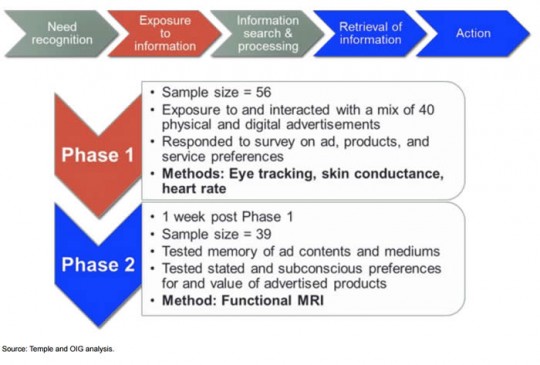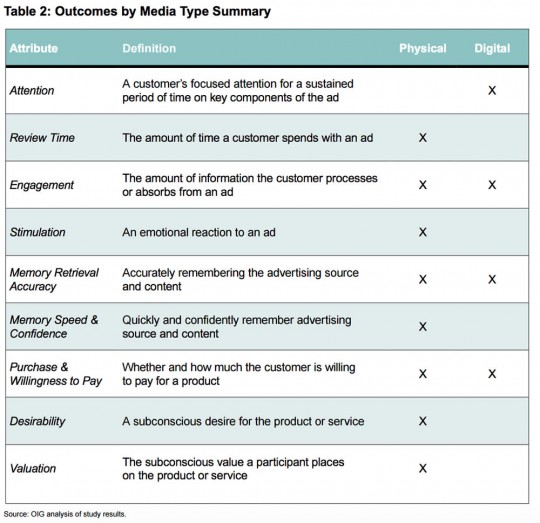Print vs. Digital: Another Emotional Win for Paper

Every year, consumers spend more time using digital devices. Every year, more media is consumed digitally. Naturally, advertising dollars are increasingly flowing to digital as well. But, don’t pull the plug on that direct mail campaign just yet. New research has again shown that content on paper affects our brains in different and more powerful ways.
The latest findings come from Temple University consumer neuroscience researchers. In a study conducted for the U.S. Post Office, they found significant differences in the way our brains process the two ad formats.
Test Methods

The scientists had subjects view ads via either digital or physical media. They used a variety of neuromarketing methods, including eye tracking and biometric measurements, to gauge the initial reactions.
A week later, many of the same subjects were put in an fMRI machine to evaluate the longer-term impact of the ads.
At several points in the process, the scientists also used traditional questionnaires to gather comparison data. The link above includes photos of the physical ad displays and experimental setup.
What They Found
Here’s a tabular summary of the results prepared by the Postal Service Office of Inspector General (OIG), who commissioned the study – the “x” indicates the medium which performed better:
Some of the interesting findings are:
- Digital ads were processed more quickly.
- Paper ads engaged viewers for more time.
- Subjects reported no preference for either medium.
- Subjects absorbed about the same amount of information from both media.
- A week later, subjects showed greater emotional response and memory for physical media ads.
- Physical ads caused more activity in brain areas associated with value and desire.
In a previous series of experiments, the same Temple researchers showed that the the ventral striatum was the brain structure whose activity was most predictive of future purchasing behavior. (See Neuromarketing: Pseudoscience No More and my podcast, Scientists Get Closer to The “Buy Button” in The Brain with Angelika Dimoka, Paul Pavlou and Vinod Venkatraman.)

Notably, the latest set of experiments showed that physical media caused greater activation of the ventral striatum than digital media. While this doesn’t conclusively show that paper is more powerful than digital for stimulating intent to purchase, it is a finding worth exploring in more detail.
Brain scans: print ads lit up 'purchase intent' area more than digital. pic.twitter.com/Kc1KVhBCIY Click To TweetPaper vs. Mobile?
The experimental setup in these experiments used a large monitor screen for the digital ad display. Today, though, both media consumption and shopping are shifting from laptop and desktop computers to mobile devices.
For me, the mobile experience is quite different than the experience on a bigger screen. And apparently it’s not just me. An New York Times article earlier this week discusses how ecommerce firms are trying to create a mobile experience that is as user-friendly as the computer. One typical consumer they quote said,
“There’s just always something, if it’s your fat thumbs or having to redo your information. I go straight to the desktop because I feel like it’s going to be easier.”
I’d love to see a similar set of experiments conducted to compare the small-screen experience to paper media. It wouldn’t be surprising if the paper vs. digital gap widened when images are much smaller and the field of view is limited.
Marketing Takeaway
There are opposing forces at work here. Marketers want to use the most effective and impactful medium, but also have to focus efforts on those media that consumers are using most. Even if we believe print ads are potentially more powerful, we have to acknowledge the massive shift to mobile devices for many daily activities.
In many cases a mix of media will be the best solution. Effective print ads will drive digital purchases. I love flipping through the richly illustrated Charles Tyrwhitt catalogs, but if I decide to place an order I’ll jump on my computer. While I’m there, I might use the site search feature to look for short-term specials or items not in the paper catalog.
The product itself makes a big difference in determining how to allocate media budgets.
If I’m browsing fine home furnishings or custom shirts, a large-format catalog will provide an experience that is more enjoyable and useful. Big, beautiful magazines like Condé Nast Traveler or Wine Spectator provide a more relaxed and luxurious way to explore both content and upscale products.
I’d contrast those desirable print vehicles with a shipping supplies catalog I (for unknown reason) receive regularly. This is a thick, heavy phone book-size catalog that can run well over 600 pages. It’s not a bad catalog, and it’s certainly comprehensive, but the products don’t generally need amazing illustrations. A utilitarian photo is fine. And, from a usability standpoint, I’m quite certain I could find a product faster on a search-enabled website than in a 664-page book.
Perhaps the shipping supply company knows their customers, and many of them prefer to shop by flipping pages. Or, maybe those customers are so excited by shipping that they actively enjoy looking at innumerable variations on the cardboard box.
For me, that costly print catalog doesn’t add much value.
Based on the new research as well as my own experience, I’d use print more heavily for things like fashion, luxury items, distinctive brands, etc. Not only will print be able to communicate the unique properties of the offering, it will allow greater emotional impact to drive purchases.
Print will be less important for utilitarian purchases, for example:
- Low-emotion products (e.g., office supplies)
- Categories with many SKUs (e.g., printer ink)
- Items where distinctive branding is less important
- Items that don’t benefit from compelling images
These and similar areas can be served effectively by well-designed digital interfaces that let customers quickly find and, if appropriate, compare products.
Even where print remains an important medium, of course, an exceptionally good digital experience is necessary both to complete print-driven sales and originate sales independently. I can’t think of a worse waste of money than distributing a gorgeous print catalog and then losing sales because of a confusing online checkout process.
Study shows print ads top digital for emotion & desire. pic.twitter.com/k0ST2tk283 Click To Tweet


Brilliant! Thank you for your fascinating piece. I’m a Graphic Designer with aspirations of Creative Directing and have developed an interest in neuromarketing along the way. I’ll be buying a copy of Brainfluence today!
Thanks, Brianna! Hope you get some great ideas!
Great article, Roger! Interesting stuff. I’ve been writing an article on advertising, so this came at the right time.
Question for you. Why do you think the print ads outperformed digital ads in those areas? I searched through the study, but I couldn’t find a specific answer.
At the moment, I still prefer digital ads. They’re easier to create, manage, and analyze. Even if they don’t generate as strong of an emotional impact, I still think I can generate a larger ROI through digital (given those benefits).
However, if there’s an underlying factor that’s making physical media more successful, it might be possible to apply that same factor to digital ads.
Unfortunately, my guess is that the main factor is a sensory experience. Although the study didn’t specify in the methodology, I’m wondering whether people were allowed to touch / hold the physical media. If so, I would guess that it made a difference.
If sensory experience IS a factor, then that means that eBooks on digital readers (e.g., Kindle) should still generate a similar impact as paperback books (because they both provide a sensory experience). But if sensory experience isn’t a factor, then paperback books might be more powerful. Sounds like we need another neuromarketing study!
Thanks for dropping by, Nick. I think paper IS part of it. I don’t have the citation, but I’ve seen studies showing that people remember better when they read something in a paper book. From personal experience, I know I can often visualize exactly where on the page I saw something. E.g., “about halfway through the book, left side, bottom third of the page, right after a sub-head.” When I read on a Kindle (actually, an iPad Kindle app) I can’t come close to doing that.
See Christian’s comment, too.
Next week I’ll be at a conference and should be able to chat with the scientists. Maybe I’ll get some more insights.
Great stuff, that confirms some of our research we did some time ago!
We had tested explicitly print vs. screen and observed a significantly higher activation of areas in the primary sensomotoric cortex with respondents who were able to correctly recall items learned on paper. We see this as a confirmation of Encoding Retrieval Overlap Hypothesis, i.e. when Information is retrieved brain areas are (re-)activated that were also part of the encoding process. This is reflected by the observation that respondents were more likely to correctly attribute paper as the source where they had learned the items than the screen.
For every-day life this may explain to the situation everybody knows that we rather know where to look for a specific Information if it was on printed matter (be it a book, a mailing or a catalogue) than somewhere in the Internet – simply because tactile Information and handling are an additional hook for the brain to retrieve Information.
We have published the results in a brief whitepaper “Papier schlägt Bildschirm” (http://www.sv-institut.de/dialogmarketing-studien/dialogmarketing-whitepaper.html), although in German only.
Thanks for the insight, Christian! I’ll check out the paper!
Great article! I was a bit concerned that the survey base was so small (less than 100), but I suspect the results would have been the same even if the base was larger.
We see these same results for our clients. To answer Nick’s question above, yes, the tactile factor adds a ton of credibility to a marketing message. There are so many Internet scams, and so much fraud, that consumers are becoming wary of “all things digital.”
In my experience, digital drives quantity, but not quality, of respondents. Direct mail, forever the workhorse medium, drives quality, but not quantity. So ROI has be viewed by the end sales numbers… and in reality, multi-channel marketing efforts will out perform any single channel campaign any day of the week.
Any article I randomly stumble upon on your blog, Roger, is full of great insights and learnings! Thank you for sharing your knowledge with the world 🙂
Out of curiosity, wanted to know if there is any such comparative study done for big screen vs small screen, i.e. desktop screen vs mobile screen for example? These days, a sister company (fashion retailer) of number one online retail company in India has been pushing mobile only policy, and has taken off the website off the shelf. I keep hearing people complaining that they will never download the app and will stop buying from this particular retailer. Any neuro-scientific insights on this aspect?
I haven’t seen a similar study comparing a phone to a computer screen, DD. That would be interesting data. From a purely practical standpoint, not having a great website experience (or any website) strikes me as a huge mistake. Yes, mobile is growing quickly, as are mobile ecommerce sales. But many customers (including me) gravitate to a big screen and keyboard for shopping. Browsing is easier, images are bigger, and if you have to enter all of your data to create an account a real keyboard is easier. This is likely most important for older customers who didn’t grow up with tiny screens and thumb typing.
I followed the link and checked out the original study to have a deeper look to the context of the ad presentation. In the photos of appendix C it seems as if the print ad was presented on a white tablet without any distracting surrounding but also without the chance to touch the ad. The digital ad was presented within an environment of an email inbox with many distracting elements around it. There were now comments about the interactions with both of the ads. Did the participant open an envelope and placed the print ad on the tablet? Even if not, why should he do this and shouldn’t have things around it like other papers, mails or other things? Did the participant open the email with a click? Why isn’t it shown bigger and without elements like email lists around it to have a presentation that is similar to that of the print ad.
My conclusion: If you change the context of the ad presentation, you change the results of the study in a way that are not any more useful.
My hypothesis: If they would have shown the same ad fullscreen on a digital tablet with a reasonable screen resolution on a white table and with the same viewing distance (similar to the print setting) there wouldn’t be very much differences.
Niels, I would say that handling the paper is a key part of the experience, whether it’s a book, magazine, catalog, direct mail piece, etc. I wouldn’t expect a paper poster in a subway car to perform better than a high-res screen in that same car.
Roger,
Very interesting. Thanks for sharing.
I may have missed it, but what was the age range of the participants?
R. Trent Thompson
@rebrandorperish
I think both ads are important because some people prefer to see print ads while some often see digital ads. I am including people who often see digital ads.
I will like to know when you did the study and if you have a recent one?